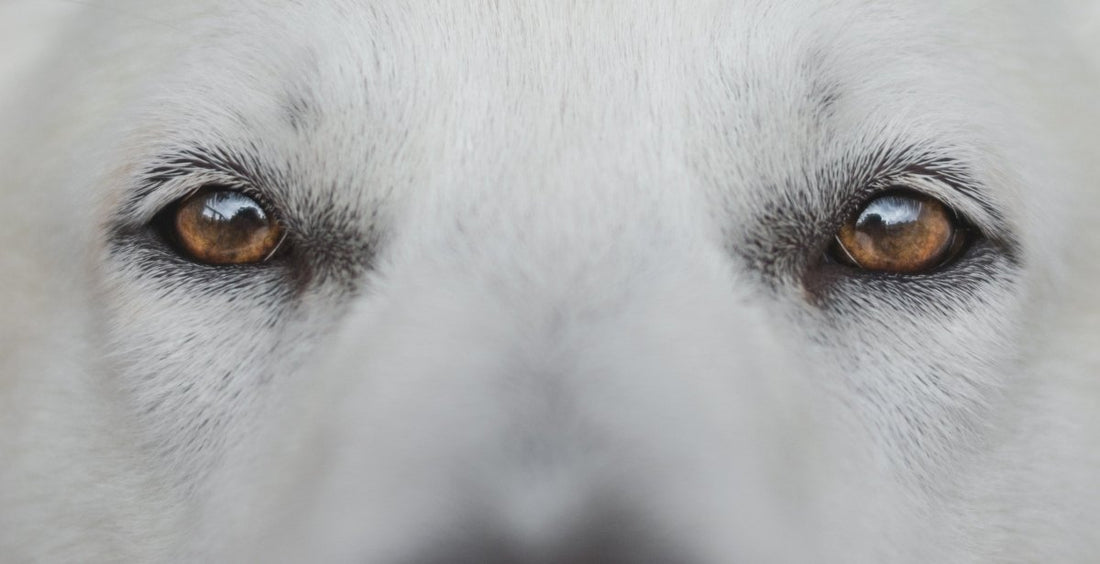Have you ever wondered how your dog sees the world around them? We humans perceive colors, movement, and light in a very specific way – but dogs do it a little differently. In this article, you'll learn everything you need to know about dog eyes: how they're structured, how dogs see, and how they differ from humans. And of course, there are also some exciting facts you can show off on your next dog walk!
How do dog eyes work?
Dog eyes are fundamentally similar in structure to human eyes—they consist of a cornea, lens, retina, iris, and optic nerve. However, despite their similar structure, there are interesting differences in function and perception.
The role of the retina: rods vs. cones
There are two types of sensory cells in the retina:
- Rods : Responsible for vision in low light and for motion detection.
- Cones : Responsible for color vision.
Dogs have significantly more rods than cones, which means they can see particularly well in twilight or darkness – significantly better than humans. However, their color perception is more limited.
How do dogs see colors?
Contrary to a widespread myth, dogs are not completely colorblind. They see colors—just differently than we do.
Color spectrum in dogs
Dogs have only two types of cones (humans have three). Therefore, they perceive the world in a limited color spectrum:
- Blue and yellow : They can distinguish well.
- Red and green : Appear to them more like shades of gray or brown.
Their color vision is comparable to that of a person with red-green color blindness.
Visual acuity: How clearly do dogs see?
Dogs' vision is less clear than that of humans. While a healthy person can distinguish details from about 25 meters away, a dog often needs a much shorter distance to see the same thing.
Why this is still not a disadvantage
What dogs lack in visual acuity, they make up for with their excellent motion detection. They can detect even the slightest movement on the horizon—ideal for hunters and herding dogs.
Night vision: Dogs are real night vision professionals
Thanks to their many rods in the retina and an additional reflective layer called the tapetum lucidum (in English: “luminous carpet”), dogs can see amazingly well even in very low light.
Why do dog eyes glow in the dark?
This special layer reflects the light and amplifies it – this is how the typical glow in dogs' eyes at night occurs when they are illuminated by a flashlight, for example.
Visual field and perception
Dogs have a larger field of vision than we do – depending on the breed, it can be up to 250 degrees (for humans, about 180 degrees).
Breed-specific differences
- Dogs with broad heads (e.g. bulldogs) : smaller field of vision.
- Dogs with long snouts and eyes set to the side (e.g. greyhounds) : Great peripheral vision, ideal for quick reactions.
Do dogs really see their humans?
Yes – but perhaps not in the way you think. They recognize us not only visually, but also combine:
- Movement patterns
- Smells
- Voice and sounds
A dog doesn't necessarily need a sharp image to recognize you. Your body language is often much more telling than your face.
Exciting fun facts about dogs' eyes
- Eye color in dogs : Usually brown, but blue or amber eyes are also possible – depending on genetics.
- Puppies are born blind : their eyes do not open until about 10-14 days later.
- Dogs blink less than humans – instead, they use other signals to communicate, such as the “calming signal” of a sideways glance.
If your dog's eye is watery or sick: How to recognize problems
As fascinating as dogs' eyes are, they are unfortunately not immune to disease. Common problems include conjunctivitis, corneal injuries, and "cherry eye" (a bulging of the nictitating membrane). Watery eyes are also a regular occurrence in many dogs – sometimes harmlessly caused by drafts or pollen. Products such as Durchblick eye care can help reduce the resulting discoloration. However, watery eyes can also be a sign of something more serious.
Look for symptoms like:
- Redness or swelling
- Frequent blinking or squinting of the eye
- Yellowish or greenish discharge
- Heavy tears over a long period of time
🩺 Tip: It's better to have your pet checked out by a veterinarian once too often – especially with eye problems, quick action is important to avoid permanent damage.
Conclusion: Dogs see differently – but not worse
Dogs' eyes are fascinating sensory organs, perfectly adapted to the needs of a four-legged friend: good night vision, high sensitivity to movement, and a sense of what's important. Even though they perceive colors differently and don't see as clearly as we do, dogs see us in their own unique way.



